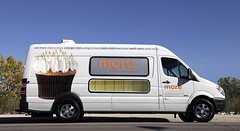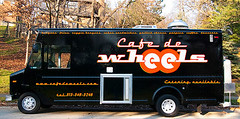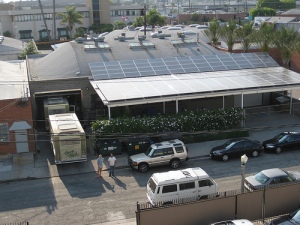In today’s economy, more than ever, people are looking for alternative sources of employment for themselves. Throw a dash of American entrepreneurship into the mix, and you will find that one of the largest growing search areas on Internet sites such as Google, Yahoo Search, and Bing! is the Mobile Food Industry. Mobile Cuisine Magazine would like to help these potential vendors and the food truck industry by providing a series of articles that will help each individual in deciding if being a mobile food vendor is the right career shift for them.
The weeks or months of refining your recipes have been concluded. You’ve spent numerous hours on the phone, waiting in line and filling out reams of paperwork at the city and county zoning and health departments. The truck you had to refinance your home to purchase has finally been outfitted with the perfect kitchen. The call from the sign company has come to inform you that the graphics and menu board are complete. You finally have done it, you’ve got your business licenses, permits and it’s time to fire up the grill and open for business. Now comes the easy part, right? It can be a 9 to 5 job, but not in the way that you might expect. This article, (the final of a four part series) will provide you with a look into a day in the life of a food truck owner.
The alarm goes off and you crawl out of bed, it is 9 a.m. The coffee is brewing and the computer is booted up so you can check on any important emails that may have come in overnight. From the time you wake up until approximately 2 hours later you will be busy going over your calendar of events, and planning for your day. To stay relevant and on the radar, you must stay in touch with customers, followers and the general public by responding to emails and phone calls. Once your correspondence is done, it’s time to start planning on events coming up in the near future. With 30 minutes to go before meeting up with team members, it’s time to get ready and drive to your meet up location.
High Noon
You and your team are on time, you go over your notes and discuss daily specials and suggestions from lessons learned from the previous day. This will be the time when you find out from your partners and line cooks what they have heard overnight from local news and their messages from customers and competitors. Sharing this information keeps everyone in the loop, part of the team, and in most cases, happy, high morale team members.
12:30 p.m. to 5:30 p.m.
Now is the time for the team to head off to the market and bakery. We suggest shopping locally weather it’s from produce markets or from local grocery chains that sell locally produced seasonal and organic fruit, vegetables and hormone-free meat. By doing this, you may spend a bit more than if you were to shop at a national chain, but not only will you provide your customers with healthy, fresh food, but you will be doing your part to assist the world in cutting down on the carbon emissions that shipping meat that is raised outside of the area and produce planted overseas creates.
Once your food is purchased you’ll need to head to the commissary to chop your fruits and vegetables, blend your sauces and grill the meat (if you serve it). Those not involved in the food prep will need to organize the truck to ready it for the work night, fire up their twitter accounts to notify followers to the truck’s location(s) and conduct another round of voice mail, email, and follow up phone calls.
5:30 p.m.
Time to head to your office; it’s time for the truck to leave the lot and get to your first stop.
6 p.m. to 2:30 a.m.
It’s time! It’s time to open the doors. It’s time to practice your trade and time to make your mark on your community. When you reach your destination and there’s already a line of people at the curb, the sight will be both invigorating and terrifying. It will be invigorating because you already have loyal followers who have found your location and are waiting to be served a meal from your heart. Terrifying because you need to park and get some meat cooking quickly so you aren’t keeping your customers waiting too long.
You will have little to no awareness of what is going on outside the truck. Your eyes will shift from the growing queue of ticket orders, to the fryers, to the main cooking surface, and back while you are preparing the orders as they come in. This is where you must enjoy your job; this is where you will know if you have made the proper choice in opening a food truck. If this is a time when you are distracted or dislike your environment, it’s time to start planning a way to sell off your investment and head back to your previous career.
3 a.m. to 5 a.m.
The night’s service is over, and you have made your way back to the commissary. It’s time to clean out the truck, and wash it down so it is ready for its next shift. The meat will need to be broken down and marinated, and bread has to be ordered for tomorrow’s pick-up.
The food is stored and the truck is locked up. It’s finally time to head home.
On the trip home you’ll reflect back on the day and be very thankful when the oil in the fryer didn’t explode or that you were able to start the truck without any issues, and finally, you’ll see it. Home sweet home. After a final round of reading emails and phone message retrieval, it’s finally time for bed.
When we mentioned a 9 to 5 work day, we’ll bet this wasn’t quite what you were expecting.
This article was not written to scare anyone, but to provide a look into a typical day of a food truck owner, and if it does scare anyone, maybe it will help save those people the time and finances that it takes to enter into this industry.
Many truck owners have told us that there is nothing glamorous about running a food truck. Why would they do it then? According to most, it’s the feeling they get when they see their customer’s laughs and smiles after taking a bite from the item they just ordered off their menu. It’s a love of cooking and serving the public. If after reading this series on Breaking into the Food Truck Industry you still have a desire to further investigate the ownership of your own truck, you may be a great fit for the industry and we support your entrepreneurial desire. Please keep following Mobile Cuisine Magazine, we will continue to profile trucks, their owners, and provide suggestions throughout the year on how owner-operators can upgrade their trucks, their products and the promotion of their businesses.


















